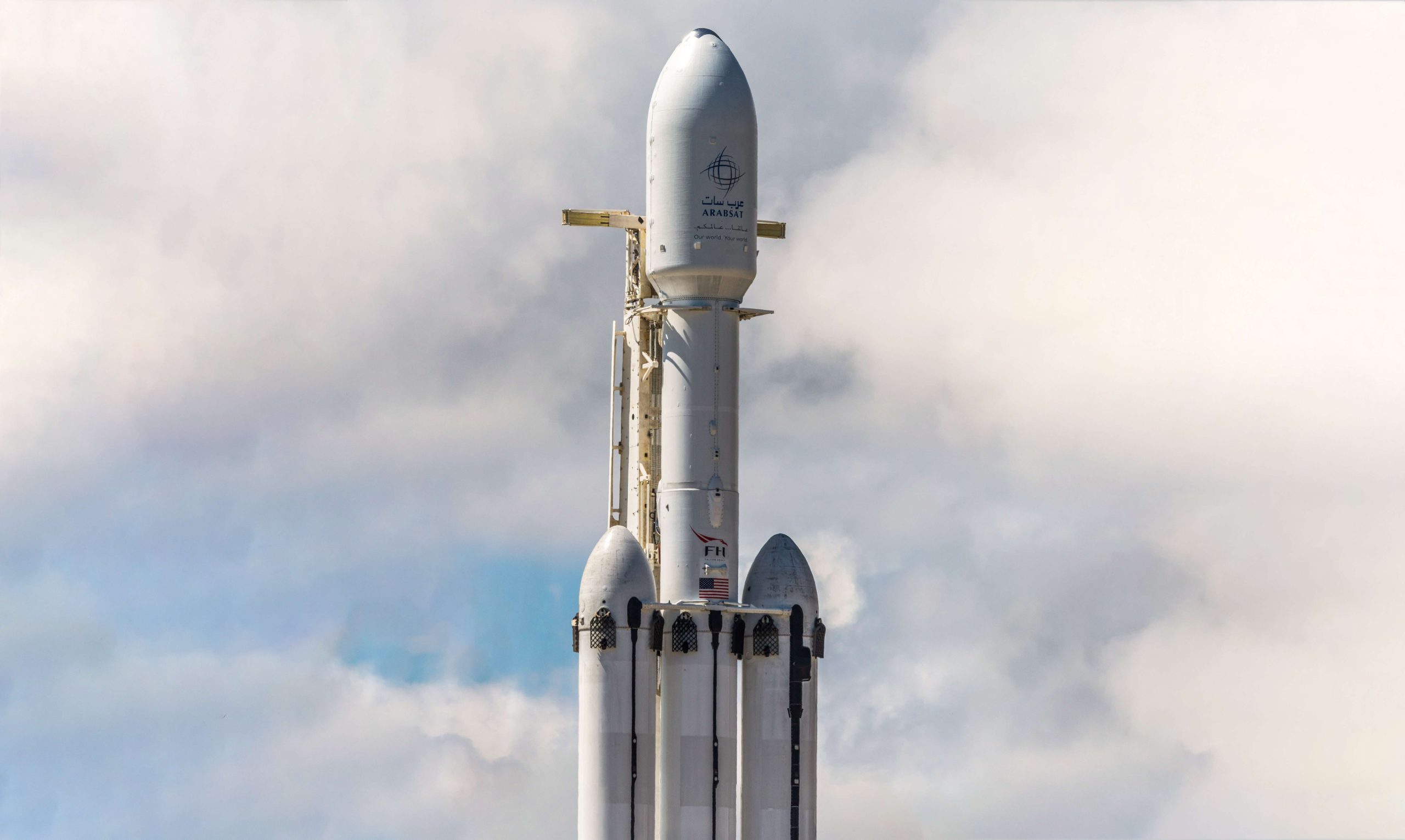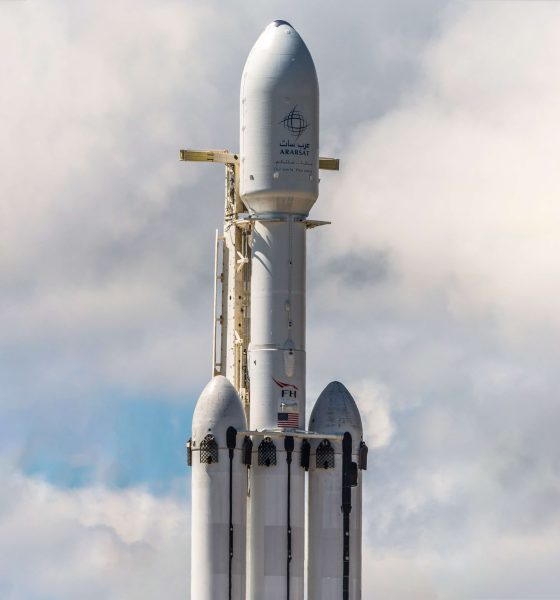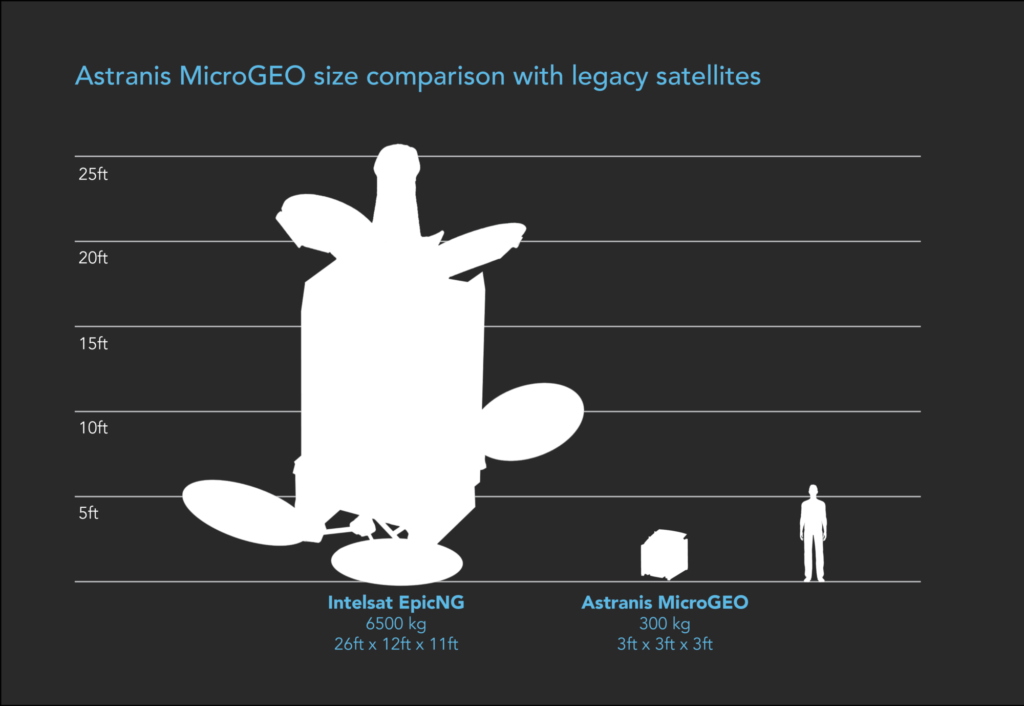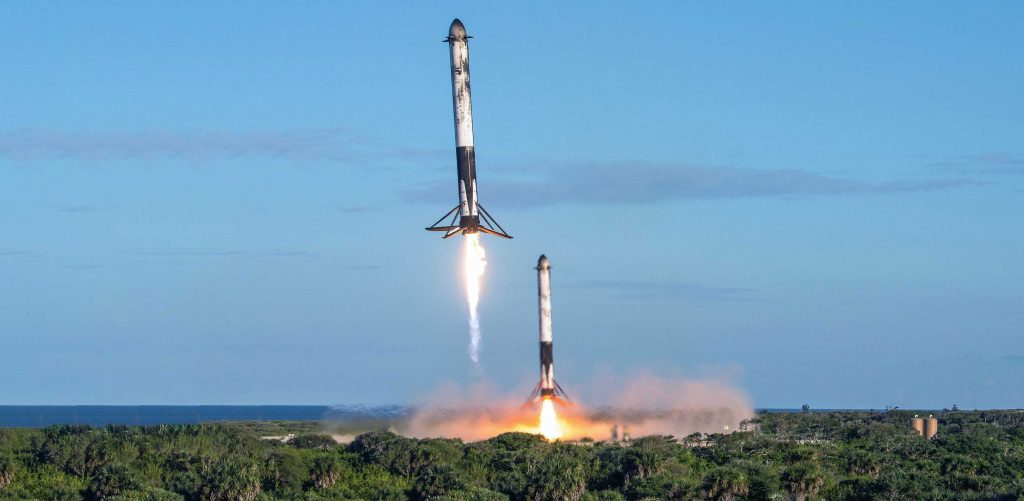

News
SpaceX’s next commercial Falcon Heavy launch to carry Astranis rideshare satellite
Geostationary satellite communications startup Astranis has decided to move its first operational satellite launch from a SpaceX Falcon 9 to a Falcon Heavy, effectively securing the massive rocket its first commercial rideshare payload.
While not technically Falcon Heavy’s first rideshare payload and not the rocket’s first commercial rideshare launch contract, Astranis’ first 400 kg (~900 lb) MicroGEO satellite nevertheless appears set to become the first commercial rideshare payload to actually fly on the world’s largest operational rocket. Not all that dissimilar to Starlink in scope and its desire to disrupt a stagnant industry, Astranis wants to offer global communications services providers a different route to geostationary internet and broadcast solutions. Unlike SpaceX’s constellation, the startup’s MicroGEO satellites are designed for geostationary orbits ~36,000 km (~22,200 mi) above Earth’s surface and more than 60 times higher than Starlink.
However, like Starlink satellites, MicroGEO will feature exceptional density (throughput per kilogram), weighing a magnitude less than average modern geostationary communications satellites while still offering up to 10 Gbps of bandwidth. Expected to cost around $40M apiece compared to ~$100M+ for most traditional offerings, the value proposition of small Astranis satellites with 5-10 times less bandwidth admittedly gets a bit blurrier, but the company should still offer a viable alternative for companies and countries that just don’t need a massive satellite.
For example, Astranis’ first customer and the buyer behind the first MicroGEO satellite – known as Aurora 4A – is Pacific Dataport, a company focused on delivering connectivity throughout Alaska – one of the most remote and sparsely populated places on Earth. That combination of attributes makes providing broadband communication services spectacularly difficult and satellite internet the perfect (and, to an extent, the only viable) solution. However, a full $100M+ geostationary communications satellite with 50-100+ Gbps of bandwidth would likely far outweigh the needs of Alaska’s ~730,000 residents – especially when most Alaskans live in the state’s few large cities, most of which already have passable internet connectivity.

As such, it’s easy to see why a small but high-performance geostationary satellite like the kind Astranis offers might be a perfect fit for an Alaskan internet provider. While low Earth orbit (LEO) constellations like OneWeb and SpaceX’s Starlink do offer far more bandwidth and a user experience potentially as good or better than a wired connection almost anywhere on Earth, both companies first have to launch hundreds or thousands of satellites to ensure continuous coverage. Both Starlink and OneWeb are a ways away from offering continuous coverage in polar regions.
Geostationary satellites – especially those as small as Aurora 4A – offer a significant shortcut, requiring just a single satellite and ground stations in one or a few very specific regions to fully complete a communications network. Of course, thanks to universal limits posed by the speed of light, geostationary internet customers end up saddled with extreme latency (ping on the order of 300-1000ms) and strict individual bandwidth limits. But in places like Alaska, where there can easily be no alternative for the most rural residents, Astranis – or just about anything – could bring welcome relief.

Now, Astranis says it has moved the first MicroGEO satellite from a SpaceX Falcon 9 rocket to rideshare payload on Falcon Heavy’s upcoming ViaSat-3 launch, scheduled no earlier than Q2 2022. According to the startup, doing so will allow the tiny satellite to begin operations over Alaska mere days or a few weeks after launch, saving months of orbit-raising thanks to Falcon Heavy’s performance. That’s only possible because, as the Astranis press release also revealed, Falcon Heavy is scheduled to launch the 6.4 ton (~14,100 lb) ViaSat-3 and 400 kg (~900 lb) Aurora 4A satellites directly to geostationary orbit (GEO). If Falcon Heavy’s upcoming USSF-44 mission launches on schedule next month, ViaSat-3 will be SpaceX’s second direct-to-GEO mission ever and the company’s first for a commercial customer.
Assuming SpaceX is still able to recover two – or even all three – of Falcon Heavy’s side boosters while launching almost 7 tons (~15,500 lb) of satellites directly to GEO, it will also demonstrate just how much of a force to be reckoned with it really is, well and truly leaving competitors ULA and Arianespace with nowhere to hide on the open market.

News
Tesla starts showing how FSD will change lives in Europe
Local officials tested the system on narrow country roads and were impressed by FSD’s smooth, human-like driving, with some calling the service a game-changer for everyday life in areas that are far from urban centers.

Tesla has launched Europe’s first public shuttle service using Full Self-Driving (Supervised) in the rural Eifelkreis Bitburg-Prüm region of Germany, demonstrating how the technology can restore independence and mobility for people who struggle with limited transport options.
Local officials tested the system on narrow country roads and were impressed by FSD’s smooth, human-like driving, with some calling the service a game-changer for everyday life in areas that are far from urban centers.
Officials see real impact on rural residents
Arzfeld Mayor Johannes Kuhl and District Administrator Andreas Kruppert personally tested the Tesla shuttle service. This allowed them to see just how well FSD navigated winding lanes and rural roads confidently. Kruppert said, “Autonomous driving sounds like science fiction to many, but we simply see here that it works totally well in rural regions too.” Kuhl, for his part, also noted that FSD “feels like a very experienced driver.”
The pilot complements the area’s “Citizen Bus” program, which provides on-demand rides for elderly residents who can no longer drive themselves. Tesla Europe shared a video of a demonstration of the service, highlighting how FSD gives people their freedom back, even in places where public transport is not as prevalent.
What the Ministry for Economic Affairs and Transport says
Rhineland-Palatinate’s Minister Daniela Schmitt supported the project, praising the collaboration that made this “first of its kind in Europe” possible. As per the ministry, the rural rollout for the service shows FSD’s potential beyond major cities, and it delivers tangible benefits like grocery runs, doctor visits, and social connections for isolated residents.
“Reliable and flexible mobility is especially vital in rural areas. With the launch of a shuttle service using self-driving vehicles (FSD supervised) by Tesla in the Eifelkreis Bitburg-Prüm, an innovative pilot project is now getting underway that complements local community bus services. It is the first project of its kind in Europe.
“The result is a real gain for rural mobility: greater accessibility, more flexibility and tangible benefits for everyday life. A strong signal for innovation, cooperation and future-oriented mobility beyond urban centers,” the ministry wrote in a LinkedIn post.
News
Tesla China quietly posts Robotaxi-related job listing
Tesla China is currently seeking a Low Voltage Electrical Engineer to work on circuit board design for the company’s autonomous vehicles.

Tesla has posted a new job listing in Shanghai explicitly tied to its Robotaxi program, fueling speculation that the company is preparing to launch its dedicated autonomous ride-hailing service in China.
As noted in the listing, Tesla China is currently seeking a Low Voltage Electrical Engineer to work on circuit board design for the company’s autonomous vehicles.
Robotaxi-specific role
The listing, which was shared on social media platform X by industry watcher @tslaming, suggested that Tesla China is looking to fill the role urgently. The job listing itself specifically mentions that the person hired for the role will be working on the Low Voltage Hardware team, which would design the circuit boards that would serve as the nervous system of the Robotaxi.
Key tasks for the role, as indicated in the job listing, include collaboration with PCB layout, firmware, mechanical, program management, and validation teams, among other responsibilities. The role is based in Shanghai.
China Robotaxi launch
China represents a massive potential market for robotaxis, with its dense urban centers and supportive policies in select cities. Tesla has limited permission to roll out FSD in the country, though despite this, its vehicles have been hailed as among the best in the market when it comes to autonomous features. So far, at least, it appears that China supports Tesla’s FSD and Robotaxi rollout.
This was hinted at in November, when Tesla brought the Cybercab to the 8th China International Import Expo (CIIE) in Shanghai, marking the first time that the autonomous two-seater was brought to the Asia-Pacific region. The vehicle, despite not having a release date in China, received a significant amount of interest among the event’s attendees.
Elon Musk
Elon Musk and Tesla AI Director share insights after empty driver seat Robotaxi rides
The executives’ unoccupied tests hint at the rapid progress of Tesla’s unsupervised Robotaxi efforts.

Tesla CEO Elon Musk and AI Director Ashok Elluswamy celebrated Christmas Eve by sharing personal experiences with Robotaxi vehicles that had no safety monitor or occupant in the driver’s seat. Musk described the system’s “perfect driving” around Austin, while Elluswamy posted video from the back seat, calling it “an amazing experience.”
The executives’ unoccupied tests hint at the rapid progress of Tesla’s unsupervised Robotaxi efforts.
Elon and Ashok’s firsthand Robotaxi insights
Prior to Musk and the Tesla AI Director’s posts, sightings of unmanned Teslas navigating public roads were widely shared on social media. One such vehicle was spotted in Austin, Texas, which Elon Musk acknowleged by stating that “Testing is underway with no occupants in the car.”
Based on his Christmas Eve post, Musk seemed to have tested an unmanned Tesla himself. “A Tesla with no safety monitor in the car and me sitting in the passenger seat took me all around Austin on Sunday with perfect driving,” Musk wrote in his post.
Elluswamy responded with a 2-minute video showing himself in the rear of an unmanned Tesla. The video featured the vehicle’s empty front seats, as well as its smooth handling through real-world traffic. He captioned his video with the words, “It’s an amazing experience!”
Towards Unsupervised operations
During an xAI Hackathon earlier this month, Elon Musk mentioned that Tesla owed be removing Safety Monitors from its Robotaxis in Austin in just three weeks. “Unsupervised is pretty much solved at this point. So there will be Tesla Robotaxis operating in Austin with no one in them. Not even anyone in the passenger seat in about three weeks,” he said. Musk echoed similar estimates at the 2025 Annual Shareholder Meeting and the Q3 2025 earnings call.
Considering the insights that were posted Musk and Elluswamy, it does appear that Tesla is working hard towards operating its Robotaxis with no safety monitors. This is quite impressive considering that the service was launched just earlier this year.








